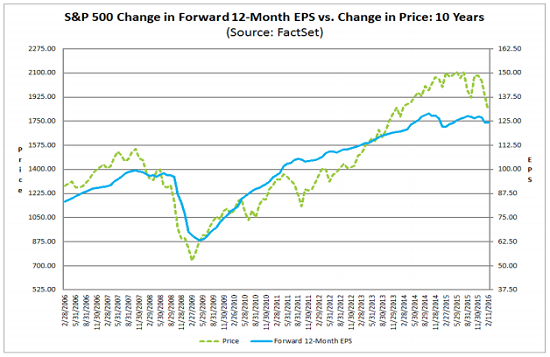Corporate earnings are falling like it's 2009
The fourth-quarter earnings season has just about wrapped up, with 74 percent of S&P 500 companies reporting results through Friday. Let's not obfuscate: Those results have been a disaster due mainly to the drag from the energy and materials sectors.
Based on what's driving the weakness, the underperformance looks set to continue.
The overall earnings growth rate has been -3.7 percent. If that rate remains negative as the last reports roll in, which looks likely, it will mark the first time the S&P 500 has seen three consecutive quarters of year-over-year declines in earnings since the first three quarters of 2009. And it caps a run of stalled profitability going back to the summer of 2014, which coincides with the peak in crude oil prices and the start of a bullish run in the U.S. dollar.
Breaking it down further, fourth-quarter earnings have beaten expectations by just 0.3 percent (the weakest in four years). Only 55 percent of companies have beaten earnings estimates, 44 percent have beaten sales estimates and just 29 percent have beaten on both.
In addition to weak energy prices and a strong dollar, new issues are appearing as well. They include a tightening labor market (increasing unit labor costs) and renewed declines in long-term interest rates (which weigh on the net interest margins banks collect). All suggest earnings growth could remain in negative territory longer than many investors realize.
That's bad news for the stock market -- and for the economy at large.
As noted by Ed Yardeni at Yardeni Research, many big companies are responding to the drop in profitability by pulling back hard on capital spending -- factories, machinery and new hires -- which directly translates into lower GDP growth. Many companies in the energy sector are suffering layoffs as oil and gas wells are idled. Lower earnings translate into higher valuation multiples for equities.
It's no wonder the economists at Wells Fargo just cut their 2016 U.S. GDP estimate from 2.5 percent to 2.1 percent.
Despite marked-down expectations, analysts at Bank of America Merrill Lynch note that Wall Street shows no signs of slowing estimate cuts: The proportion of companies now expected to post losses is at levels seen before the last two bear markets. With another -5 percent year-over-year decline penciled in for first-quarter 2016, earnings growth isn't forecast to return until 2016's second quarter.
Assuming a bear market scenario isn't in play, predicated largely on a rebound in crude oil, Deutsche Bank suggests recent stock price declines have made many areas of the market attractive despite the earnings softness. The list includes health care, technology, financial and many consumer discretionary stocks.

